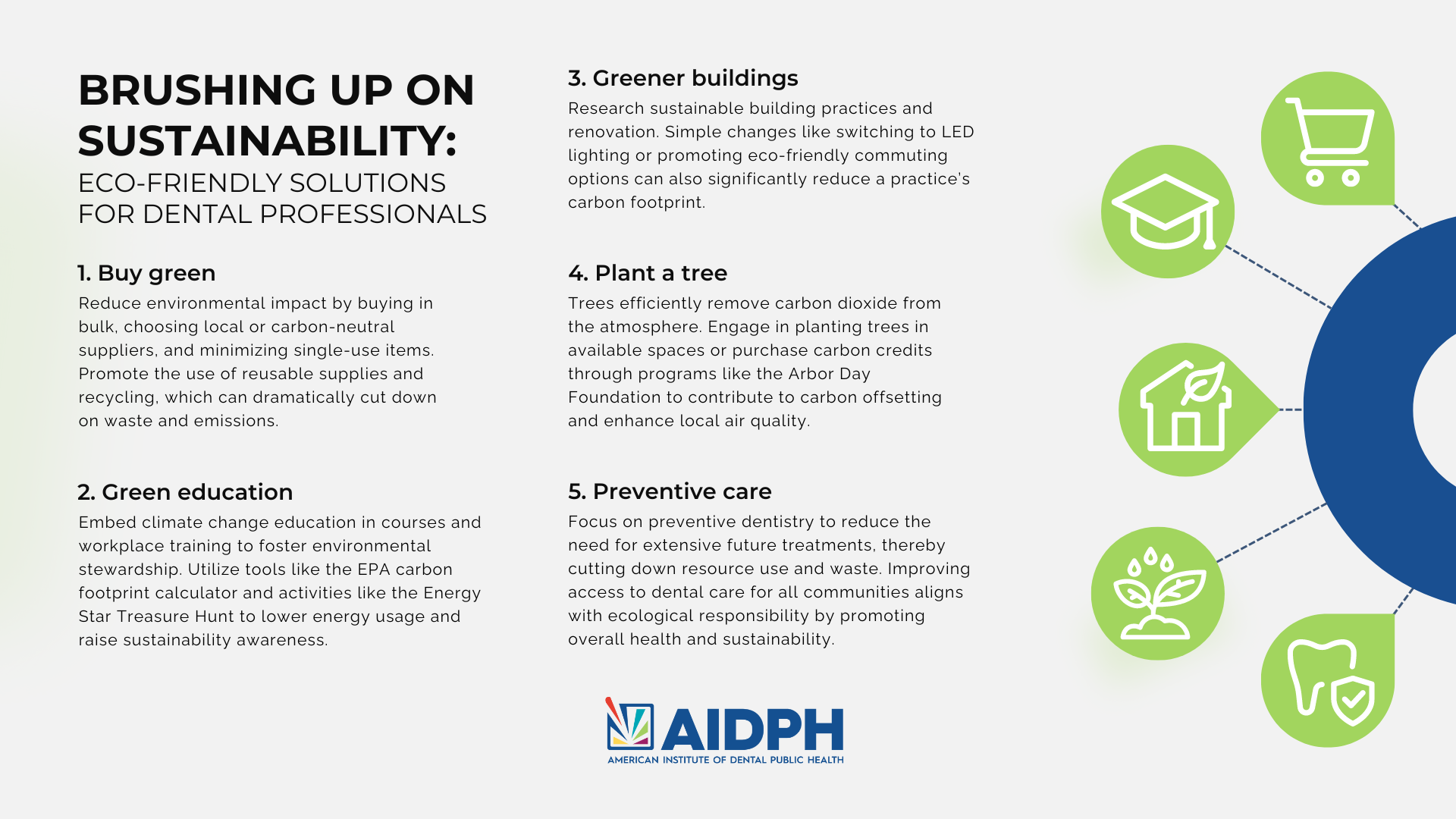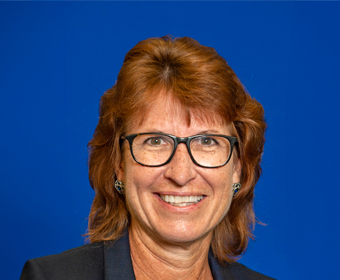By Janice Hawkins, PhD, RN, CNS, FAAN
As an AIDPH Board Member and a registered nurse working to promote the United Nations Sustainable Development Goals – particularly good health and well-being for all – I’m concerned about the negative health impacts of climate change. Climate change poses a serious health threat, especially to some of our most vulnerable populations.
One strategy to mitigate climate change in healthcare is to reduce our carbon footprint. Currently, the healthcare industry, including oral healthcare, is responsible for over 8% of carbon emissions in the US and more than 4% globally. A recent study done in the UK suggests that the carbon footprint of dental practices is rising, which could have implications for practices in the States. With climate related deaths predicted to increase annually, healthcare providers are obliged to take action.
Unfortunately, marginalized groups are already experiencing disproportionate effects from climate change. This includes people with disabilities and rural communities, two of AIDPH’s core communities of focus. According to the Harvard University Center for the Environment, people with disabilities are “two to four times more likely to die or be injured in climate emergencies including heatwaves, hurricanes, and floods,” have a more difficult time getting to emergency shelters, and are more likely to face institutionalization after a disaster, instead of being able to return home. Additionally, the US Climate Resiliency Toolkit says that rural communities often have limited resources and infrastructure in place to prepare for natural disasters. Rural economies often rely on agriculture, fishing, and forestry, and all three of these industries are highly susceptible to the impacts of climate change.
Sharing ideas for greener dental practices will contribute to lowering carbon emissions and improving overall health outcomes for vulnerable communities, as well as the population as a whole. Whether you are a provider, program manager, or patient, here are a few ideas:
1. Buy Green
Wasteful packaging and lengthy shipping distances are both big contributors to greenhouse gas emissions. Consider buying in bulk, buying from local vendors when possible, or seeking out eco-friendly carbon neutral suppliers to reduce transportation miles. A carbon neutral supplier is a supplier company that commits to balancing the carbon dioxide they release with the carbon dioxide they remove from the atmosphere, usually by lowering their emissions and purchasing carbon offsets.
In addition, minimizing single use items in dentistry can lower waste by as much as 33% in packaging materials. For instance, some dental practices have switched to bamboo toothbrushes over plastic and make use of other eco-friendly supplies. When possible, consider purchasing reusable supplies, and encourage recycling for non-reusable supplies; separating plastics for recycling could help save 5kg of waste a week.
2. Green Education
Preparing the future workforce to be better stewards of our planet benefits us all. I personally include climate change content in my courses. I’m proud that my university was just recognized by the Times Higher Education Impact Rankings for making significant contributions toward sustainable development.
But learning to become a better steward for the environment doesn’t stop in the classroom; educating and incentivizing team members can help to reduce energy use both at home and in the office. The EPA carbon footprint calculator is a useful tool for raising awareness of energy use and developing a plan to lower emissions. In the office, consider holding an Energy Star Treasure Hunt, where team members search the building for quick ways to save energy. At my institution, we use the treasure hunt as a required class assignment for our nursing students, who look for ways to reduce energy use at the university.
Even consumers can benefit from learning more about how to reduce their carbon footprint. Water waste contributes to carbon emissions, so educating patients to turn off the water when brushing their teeth except for rinsing can save almost 4 gallons of water per brush.
3. Greener Buildings
Building or converting an office according to LEED (Leadership in Energy and Environmental Design) standards with the help of a qualified professional is an excellent way to ensure your practice is as green as possible. LEED is a rating and certification system which assesses buildings based on sustainability elements such as energy efficiency and using low-impact building materials.
However, simple switches can still be a great way to make progress in reducing a practice’s environmental impact. For instance, by switching to LED lighting, one healthcare system in California not only lowered their energy use but also saved $350,000 a year. Similarly, with transportation accounting for up to 28% of carbon emissions in the US, encouraging getting to work via public transportation, bike riding, or carpooling has the potential to make a large impact on lowering overall emissions. Another strategy is to consolidate the work week to 4 days rather than the traditional five, which can significantly reduce transportation-related CO2 emissions, and saves energy use on overhead lighting, office heating, etc.
4. Plant a Tree
Planting a tree in your parking lot or available green spaces helps protect our planet. Trees are the most efficient way to remove carbon from the atmosphere. According to the More Trees blog, some of the best trees for carbon offsetting are fast-growing, long-living, low-maintenance, and large leaf and native species. At my university, we obtained a small grant to plant trees on our campus. Our nursing students also used this opportunity to share some of the health benefits of trees. Another option is to purchase trees to offset your carbon emissions. The Arbor Day Foundation offers a carbon offset calculator to estimate the amount of carbon credits based on carbon emission levels.
5. Preventative Care
Preventive dentistry decreases the need for future services, reducing waste and improving patient care outcomes. Improving access to care, particularly for underserved and marginalized communities, is a core value of AIDPH. We believe it’s the right thing to do for our patients. It’s also the right thing to do for the planet.

Although we still have a long way to go in terms of improving harmful environmental policies, individual actions taken by practices, providers, and educators are still an important piece of the puzzle. And increasingly, oral health providers are taking steps to green their practices. Reducing waste in healthcare not only lowers carbon emissions, but also saves money. And, a growing number of patients prefer to do business with dental practices that are committed to sustainability.
Ultimately, more sustainable practices in oral healthcare is good for business and the bottom line. But more importantly, actions to mitigate climate change protect the health of our patients and our planet. I hope you’ll not only take these recommendations to heart, but also share your environmental successes to encourage others to do the same.

Janice Hawkins, PhD, RN, CNS, FAAN
AIDPH Board of Directors
About the Author
Janice Evans Hawkins, PhD, RN, CNS, FAAN is an Assistant Professor and Chair of Graduate Nursing Programs at Old Dominion University. Dr. Hawkins also serves on the AIDPH Board of Directors and Oral Health Community Engaged Research (OHCER) Task Force. She has been a nurse educator for over 25 years with a focus on reducing health disparities and preparing a healthcare workforce equipped to care for vulnerable populations. She has presented internationally and published in both peer-reviewed journals and popular media. Her contributions have equipped educators with evidenced based strategies to infuse advocacy and oral health content into nursing curricula and mobilized health science students to actions to improve oral healthcare, vaccine access, and climate mitigation. Her contributions to the nursing profession and addressing health inequities were recognized with her induction as a Fellow of the American Academy of Nursing.



